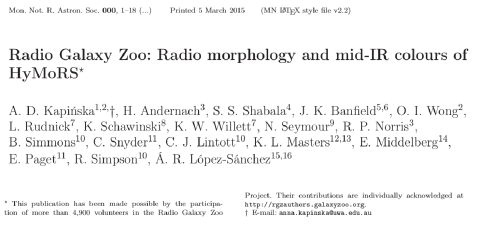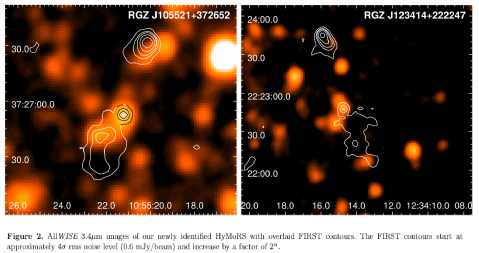Radio Galaxy Zoo searches for Hybrid Morphology Radio galaxies (HyMoRS): #hybrid
First science paper on hybrid morphology radio galaxies found through Radio Galaxy Zoo project has now been submitted!
 In the paper we have revised the definition of the hybrid morphology radio galaxy (HyMoRS or hybrids) class. In general, HyMoRS show different Fanaroff-Riley radio morphology on either side of the active nucleus, that is FRI type on one side and FRII on the other side of their infrared host galaxy. But we found that this wasn’t very precise, and set up a clear definition of these sources, which is:
In the paper we have revised the definition of the hybrid morphology radio galaxy (HyMoRS or hybrids) class. In general, HyMoRS show different Fanaroff-Riley radio morphology on either side of the active nucleus, that is FRI type on one side and FRII on the other side of their infrared host galaxy. But we found that this wasn’t very precise, and set up a clear definition of these sources, which is:
”To minimise the misclassification of HyMoRS, we attempt to tighten the original morphological classification of radio galaxies in the scope of detailed observational and analytical/numerical studies undertaken in the past 30 years. We consider a radio source to be a HyMoRS only if
(i) it has a well-defined hotspot on one side and a clear FR I type jet on the other, though we note the hotspots may `flicker’, that is their brightness may be rapidly variable (Saxton et al. 2002), and, in the case the radio source has a very prominent core or is highly asymmetric,
(ii) its core prominence does not suggest strong relativistic beaming nor its asymmetric radio structure can be explained by differential light travel time effects. ”
Based on this we revised hybrids reported in scientific literature and found 18 objects that satisfy our criteria. With Radio Galaxy Zoo during the first year of its operation, through our fantastic RadioTalk, you guys now nearly doubled this number finding another 14 hybrids, which we now confirm! Two examples from the paper are below:

We also looked at the mid-infrared colours of hybrids’ hosts. As explained by Ivy in our last RGZ blog post (https://blog.galaxyzoo.org/2015/03/02/first-radio-galaxy-zoo-paper-has-been-submitted/), the mid-infrared colour space is defined by the WISE filter bands: W1, W2 and W3, corresponding to 3.4, 4.6 and 12 microns, respectively.
The results are below:
For those of you interested in seeing the full paper, we will post a link to freely accessible copy once the paper is accepted by the journal and is in press! 🙂
Fantastic job everyone!
Anna & the RGZ science team

